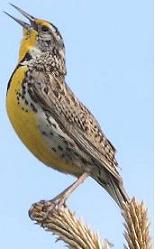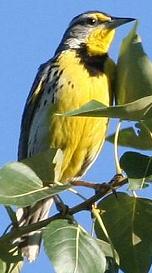Western Meadowlark
The distinctive black V across the yellow
breast of Western meadowlarks is a common site along roadsides
and in fields across much of North America. It is the state
bird of 6 states.
Identification and Pictures
(Sturnella neglecta) 81/2 to 11 inches
Western meadowlarks have a bright yellow throat, and breast
crossed with a black V. Their sides, and under-tail feathers are a
white with dark spots, and streaks. Their upper parts are a
mix of buffs, browns, and black streaks. A bright yellow line
runs over the eye to long slender bill. The birds have a short tail, and long legs.
Adult birds have a dark crown with a white stripe. When
approached on the ground their white tail feathers will be
visible as they run away giving a sharp alarm.
The sexes look similar, but the female is smaller and
has less marking. Eastern meadowlarks are similar, but
the yellow throat extends farther into the face in
Western meadowlarks.
Photos by Keith Lee. The camera I use is
the Canon EOS
40D and a 70 to 300 zoom lens.
Range and Habitat
Western meadowlarks can be found from British Columbia, Manitoba, northern Michigan, and Ohio south to Missouri, central Texas,
and northern Mexico. They like grasslands and open country with plains, and meadows.
Most will stay within breeding areas in winter, but may move into the valleys when deep snow covers their food sources. They will flock in the winter sometimes with other blackbirds.
There are some populations that migrate south.
Breeding and Nesting
Male meadowlarks arrive to claim their territory a couple weeks before the females.
They will claim about six or seven
acres, and stand guard, singing from fence posts, and wires.
If another male dares to intrude on the territory it will be attacked.
When they fight they lock feet, and peck at each
other rolling around on the ground. When one escapes, and
flies away, the victor will pursue it out of the territory.
Shortly after the female arrives she will initiate a series of aerial chases.
These are short flights
followed by periods on the ground with male posturing. He struts around the female, puffing his chest, and standing erect.
During this dance the female will stand with her bill, and tail elevated, and her wings drooped slightly.
Males will mate with more than one female at a time. The nest the female builds is a grass dome
concealed in thick grass on the ground. She will incubate 3 to 7
white spotted eggs for around 14 days. The female will do most of the feeding, and the young will leave the nest in about 10
days although they will not be able to fly yet. The
female may have 2 broods a year.
Song and Call
Meadowlarks have many songs and calls, flute like notes with
guttural chatter. Growing up in Montana the two bird songs I
remember signaling the arrival of spring were the robin, and the loud melody of the
meadowlark.
Both sexes sing, however the loud
territorial song of the male is the sound most people are familiar with.
Western meadowlarks sing continually from tree tops, and
fence posts, or utility poles in their territory. A male will have as many as 10 different songs, usually switching
songs if another male is present.
Western
Meadowlark song
Food
Insects are the main diet of meadowlarks in the summer as they forage mostly on the ground, probing the soil with their bills.
In fall, and winter they eat seeds.
To learn about other favorite
birds click here.

|
